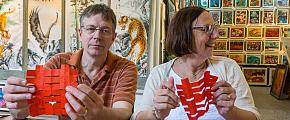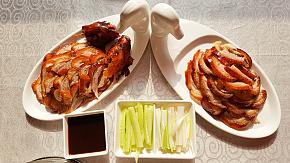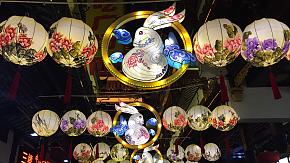Drinks and Snacks of China - Moon Cake, Dough Flowers, Spring Rolls
Moon Cake (Yuebing)
The Chinese moon cake is for the Mid-autumn Festival and is so-called because it is made in the form of a disc representing the full moon of the festival. The cake consists of a crust and stuffing. The crust is made in varying ways and with varying degrees of crispness, but the usual main ingredients are wheat flour, oil or fat, sugar, and maltose. Part of the flour is mixed with water to make a dough, and the rest is kneaded with fat. These arranged in alternate layers become the crust after baking.
 Moon Cake (Yuebing)
Moon Cake (Yuebing)
A wide variety of materials may be used for the stuffing; these include Chinese ham, sausage, walnut meat, pine nuts, and almonds. The usual flavorings are osmanthus flowers, rose petals, and other natural essences. Moon cakes are normally called by the fillings they contain assorted fruits, five nuts, rose, ham, jujube paste, pepper and salt, and so on. The stuffing, as already shown, may be either sweet or salty or mixed in taste. There are literally a thousand and one kind of moon cakes made in different regions of China, but it is generally agreed that the best moon cakes are produced by three schools - Jiangsu, Guangdong, and Beijing.
Although the form of the moon cake is traditionally round, several localities have in recent years broken away from the tradition by experimenting with a square. oblong and triangular moon cakes.
Mianhua, called "Huamo" and "Huamantou"(steamed bread flower) in Heyang County, is a kind of folk steamed bread for sacrifice, widely spread among Chinese people.
Dough Flowers (Mianhua)
A dough flower is not only food but a work of art nice to look at. As the name implies, they are made of wheat flour, though sometimes mixed with glutinous rice flour low greater stickiness.
They are popular in the Chinese countryside, and those made in Luochuan in northern Shanxi Province, called huamo (or "flowery bread") by the local people, are particularly well-known. On the eve of festivals or ceremonial occasions such as a wedding or a funeral, the local womenfolk will inevitably turn their thought to preparing dough flowers. No patterns are needed, but their nimble fingers can in no time shape a ball of dough into a flower, a bird, a chick, or a duckling.
A blossoming flower is made by cutting out the petals with scissors, the plumage of bird wings by pressing with a comb, and black or green beans will make the eyes of little animals. Then the modeled figures are cooked by steaming and brightened up with coloring. Peaches made of steamed dough, a symbol of longevity for birthday parties of elderly people, are usually dyed red and yellow after the natural ones. Dough flowers are normally sweet in taste and served at dinners between the dishes. Some are prepared by mixing natural, colorful vegetable juices into wheat flour, and they look particularly delightful and appetizing.
Spring Rolls (Chunjuan)
Spring rolls are a great favorite with the Chinese, they are also very much appreciated abroad. At receptions given by Chinese embassies or consulates, spring rolls often prove to be a gastronomic delight to the guests. It is not without reason that they are served by Chinese restaurants abroad at many times the price they are sold in China. In China, their appearance on the dining table with their inviting brown color has rarely failed to cause foreign tourists to click their tongues in admiration. The principal ingredient for the fillings in spring rolls is usually bean sprouts, which are mixed with shredded pork dried mushroom plumped and shredded, vermicelli, shredded bamboo shoots, and the necessary seasonings. The fillings are rolled up in thin wrappers of dough, and the resulting rolls are deep-filled in oil and served hot when the wrappers are still crisp. The stuffing of the spring rolls is generally seasoned with salt, but there is a minority of people who use sweetened bean paste as the fillings. Apart from being served at dinners, spring rolls are also sold as takeaway snacks in some restaurants.
 Spring Rolls (Chunjuan)
Spring Rolls (Chunjuan)
New Year Cake (Nian Gao)
At the Spring Festival, namely, the Chinese traditional New Year. most Chinese families will eat the New Year cake (Nian Gao) which is made of glutinous rice or millet flour and garnished with various auxiliary materials such as bean or jujube paste, assorted fruits, assorted preserves, and so on. The cake is divided into two categories, the yellow one and the white one, representing respectively gold and silver. It used to be the belief that eating Nian Gao at New Year would bring good luck.
New Year cakes may be cooked by steaming or flying and are served in either case with sugar sprinkled on. Down in the south, there is another way of preparation, that is, to soak a kind of plain, ungarnished cake in water and then cut it into stir-fried in a cooking pot with oil and salt, mixed often with spinach or other greens.
Pyramid-Shaped Glutinous Rice Dumplings (Zongzi)
Pyramid-shaped dumplings made of glutinous rice wrapped in bamboo or reed leaves are a traditional Chinese food for the Dragon Boat Festival which falls on the 5th of the 5th lunar month. The festival, popular among the Han people by tradition, was first established during the Warring States Period (475-22l B.C.) in memory of Qu Yuan, a celebrated poet who was a high official of the state of Chu.
A passionate reformist, he courted the wrath of conservatives, who talked the King of Chu into sending him into exile. Dismayed by his failure to salvage his country, Qu Yuan drowned himself in the Miluo River on the 5th of the 5th lunar month in 278 B.C. His fellow countrymen made it a point to honor the memory of this great patriotic poet by sailing dragon boats down the miluo River and throwing pyramid-shaped rice dumplings into the water to feed his soul. Such is the origin of the Chinese tradition of holding dragon boat races and eating pyramid-shaped rice dumplings on the 5th of the 5th lunar month.
Eight-Treasure Rice Pudding (Babaofan)
The Eight-treasure Rice Pudding is made from glutinous rice supplemented with red jujubes, lotus seeds, lily, seeds of Job's tears, ginkgo, dried longan pulp, and finely cut green and red plums. These ingredients may also be substituted with walnut meat, haw jelly, raisin, peanut, and cherry. The Eight-Treasure Rice Pudding is used as a banquet course for its pleasant color, fragrance, taste, and shape. In some places, brown sugar is melted with burning liquor and as the icing for the Eight-treasure Rice Pudding in some places. This practice of burning Liquor to melt brown sugar originated in the story of the eight scholars recruited by King Wen of the Western Zhou Dynasty in present-day Xi'an to conquer the tyrannical King Zhou of the Shang Dynasty.
These scholars, included Bo Da, Bo Shi, and Zhong Tu. Shu Ye. and Shu Xia, indeed played a positive role in toppling the Shang Dynasty. When the triumph over King Zhou was celebrated in the Zhou capital city of Hao, the chefs of the imperial kitchen concocted a kind of pudding made from eight treasured ingredients, and topped it with fiery-colored haw juice to symbolize the “eight Zhou scholars burning King Zhou of Shang to death”. The Eight-treasure Rice Pudding thus came down through the generations as a favored course of the Chinese banquet. According to Chinese tradition, the Eight-treasure Rice Pudding is served and eaten on the 7th of the 1st lunar month to mark the end of the Spring Festival and the beginning of the New Year.
Related Posts You May Like
What Our Clients Say
"Great Customized Service", "Trip of A Lifetime", "Exceed All Expectations"







